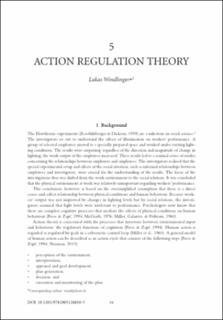Please use this identifier to cite or link to this item:
https://doi.org/10.21256/zhaw-22745| Publication type: | Book part |
| Type of review: | Editorial review |
| Title: | Action regulation theory |
| Authors: | Windlinger Inversini, Lukas |
| et. al: | No |
| DOI: | 10.1201/9781003128830-5 10.21256/zhaw-22745 |
| Published in: | A Handbook of Theories on Designing Alignment between People and the Office Environment |
| Editors of the parent work: | Appel-Meulenbroek, Rianne Danivska, Vitalija |
| Page(s): | 54 |
| Pages to: | 67 |
| Issue Date: | 2021 |
| Publisher / Ed. Institution: | Routledge |
| Publisher / Ed. Institution: | Oxon |
| ISBN: | 9781003128830 |
| Language: | English |
| Subjects: | Action regulation; Regulation problems; Environmental stressors; Environmental comfort |
| Subject (DDC): | 158: Applied psychology 331: Labor economics |
| Abstract: | Action regulation theory addresses the cognitive regulation of actions. Action regulation is taking place on three levels: automated regulation, flexible action patterns, and intellectual regulation. These regulation levels are activated on an as-needed basis in order to sequentially perform actions contributing to achievement of goals and sub goals. Action regulation is described in terms of regulation requirements (complexity) and regulation possibilities (control). Applied to the work environment it provides a psychological account of regulation problems or environmental stressors in three broad categories. Regulation obstacles refer to regulation difficulties caused by unfavourable environmental conditions and interruptions by people. Overtaxing regulations refers to overload caused by overstimulation by task inherent factors, physical environment, or social environment. Regulation uncertainty refers to qualitative overload. Action regulation theory generally contributes to the understanding of job demands, resources, and stressors at work and its application in workplace research allows to identify and understand environmental influences, as part of work conditions, on employees. |
| URI: | https://digitalcollection.zhaw.ch/handle/11475/22745 |
| Fulltext version: | Published version |
| License (according to publishing contract): | CC BY-NC-ND 4.0: Attribution - Non commercial - No derivatives 4.0 International |
| Departement: | Life Sciences and Facility Management |
| Organisational Unit: | Institute of Facility Management (IFM) |
| Appears in collections: | Publikationen Life Sciences und Facility Management |
Files in This Item:
| File | Description | Size | Format | |
|---|---|---|---|---|
| 2021_Windlinger_Action-regulation-theory.pdf | 355.22 kB | Adobe PDF |  View/Open |
Show full item record
Windlinger Inversini, L. (2021). Action regulation theory. In R. Appel-Meulenbroek & V. Danivska (Eds.), A Handbook of Theories on Designing Alignment between People and the Office Environment (pp. 54–67). Routledge. https://doi.org/10.1201/9781003128830-5
Windlinger Inversini, L. (2021) ‘Action regulation theory’, in R. Appel-Meulenbroek and V. Danivska (eds) A Handbook of Theories on Designing Alignment between People and the Office Environment. Oxon: Routledge, pp. 54–67. Available at: https://doi.org/10.1201/9781003128830-5.
L. Windlinger Inversini, “Action regulation theory,” in A Handbook of Theories on Designing Alignment between People and the Office Environment, R. Appel-Meulenbroek and V. Danivska, Eds. Oxon: Routledge, 2021, pp. 54–67. doi: 10.1201/9781003128830-5.
WINDLINGER INVERSINI, Lukas, 2021. Action regulation theory. In: Rianne APPEL-MEULENBROEK und Vitalija DANIVSKA (Hrsg.), A Handbook of Theories on Designing Alignment between People and the Office Environment. Oxon: Routledge. S. 54–67. ISBN 9781003128830
Windlinger Inversini, Lukas. 2021. “Action Regulation Theory.” In A Handbook of Theories on Designing Alignment between People and the Office Environment, edited by Rianne Appel-Meulenbroek and Vitalija Danivska, 54–67. Oxon: Routledge. https://doi.org/10.1201/9781003128830-5.
Windlinger Inversini, Lukas. “Action Regulation Theory.” A Handbook of Theories on Designing Alignment between People and the Office Environment, edited by Rianne Appel-Meulenbroek and Vitalija Danivska, Routledge, 2021, pp. 54–67, https://doi.org/10.1201/9781003128830-5.
Items in DSpace are protected by copyright, with all rights reserved, unless otherwise indicated.